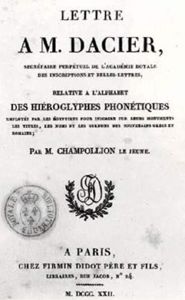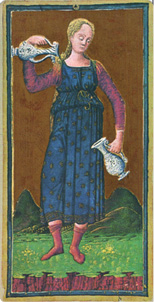“No one will hide a valuable object in something of great value, but many a time one has tossed countless thousands into a thing worth a penny.”
(Gospel of Philip)
Tarot: “
Each of the illustrated cards which make up the Tarot deck. The term was first used approximately a century after the invention of the deck, estimated circa 1500. Its origin is even now obscure.
”
Is it correct, the definition we are used to hearing when speaking of this deck of cards ? Scholars maintain that the term Tarot, whose etymological origin is still uncertain, was first used in XVII- century Italy. The term is in any case, mostly used in the plural. The ample literature on the subject shows us however that its etymology is not the only thing in doubt: its origin as well is not certain. Almost all researchers presume that they were created in Italy around the XV century, during the Renaissance therefore. Actually, this is merely a hypothesis, but because of the obsessive insistence with which it has been repeated, it has become automatically true. This approach, from the point of view of authentic scientific and historiographic research, is incorrect; in that, without definite and proven evidence, one cannot transform conjecture into fact unless there is the intention to take intentional liberties with the outcome. For example, we are convinced that the exact name is not to be found in the Italian language (Tarocchi) but rather in the term adopted by all other idioms, to wit: Tarot . Setting aside for a later time an investigation into the more complex aspects of its etymology, we will limit ourselves for the moment to note that the word is written, differently from Italian, in the singular form.
One of the most striking of the characteristics of the word Tarot is its analogy with a somewhat particular language, the so-called Language of the Birds. Here is the description of a renowned alchemist of the XX century, known by the pseudonym of Fulcanelli:
“ ...Language of the Birds, mother and doyenne of all others, language of philosophers and diplomats. Jesus reveals it to the apostles, sending them his spirit, the Holy Spirit, who teaches them the mystery of all and unveils the most hidden truths. In the medieval times of alchemy, it was called the Gay Science or Gay Knowledge. Language of the gods, Goddess-Bottle (...) Today, if we exclude the argot, we find it in some local languages, as Picard, Provencal, etc, and in the language of gypsies. 1 ”
Essentially, this language is a system of codes reclaimed from the ancient Alchemists and used also by poets and troubadours. It is a system based on a sort of Synchronicity 2 of words founded on the precept that God, Unity, the One, is at the origin of all. Although not claiming true scientific value, it reflects an elevated and spiritual logic, which, when it reveals itself, astonishes beyond any possible rational interpretation.
In the specific case of the word Tarot , we may comprehend a deeper significance only by accepting the idea that, in order to reveal its hidden message, which likewise conceals the parameters of the Unity, it is indispensable to have a suitable decryption system . To confirm this, in fact, we may observe the manner in which traditional literature, in order to explain the root of the term, has always been rich in interpretations similar in dynamics to the Language of the Birds .
For example, experts have found that, analysing the term TAROT we obtain ROTA, in Latin, Wheel, namely the astrological wheel at the centre of the Way of the Tarot. This, by its nature, is characterized by a circularity expressed as well by the two “T”s at the beginning and end of the word itself. They have also pointed out that in TAROT is contained the word TORA(H), the sacred text of the Jews, which has a close affinity with these figures; or that TAR-RO in Egyptian, means” The Royal Way”, a definition which corresponds precisely to the deepest meaning of the Tarot, being, as we will demonstrate, a true path, road or way. Even if we admit the partial validity of all these inferences and of their adherence to the principle of Synchronicity, our purpose is different. In effect, that which we wish to underline through this comparison is that, in order to understand the term “Tarot”, as to comprehend the profound essence of that which it defines, it is fundamental to use keys of decodification: the Tarot are in fact characterized, as is the Language of the Birds, by an orderly system of Codes which represent the only instrument for understanding their deepest sense. Champollion, the decoder of hieroglyphic writings, wrote to Baron Joseph Dacier, secretary of the French Royal Academy of inscription:
“ I have arrived at the point where I have a complete vision of the general structure of this form of writing, signs and rules of their combination...thus there are the bases of the grammar and the vocabulary of these writings which are to be found on the greater part of the monuments . 3 ”

Fig. 1
Lettre to Mr. Dacier, 1822
The example fits perfectly: it is obvious that we will follow a similar path in order to arrive at a complete and comprehensive vision of the whole.
The term Tarot is neither arbitrary nor subjective, but an integral part of a precise, strict and codified system. The five letters of which it is composed, however much re-elaborated in a modern language, express and at the same time conceal a sort of hieroglyphic, an ancient symbol of sacred meaning, of whose complex analysis we shall occupy ourselves later. Clearly, nothing of this is contained in the Italian term Tarocchi , which remains, independent of any conjecture, totally lacking in any intrinsic or occult meaning. Based on these data, let us be allowed one last premise.
This new and surprising vision that we propose, is a work of syncretism of diverse fields of knowledge: history, philosophy, mathematical thought, science, etc. The necessity of this manner of proceeding derives from the incontestable value of rigor and legitimacy that characterize these disciplines when applied with discernment, logic and equilibrium. However, neither shall we exclude religious doctrines of esoteric matrix, as its support may allow us to shed light on the unique sense of certain declarations. In this case, as well, in order to avoid doubt and obscurity, we will limit ourselves to deduction evident and accessible only through well-founded thought. Our intention, in fact, is not to request from the reader a blind acceptance of certain reflections (which would thus risk remaining mere postulates) but rather to allow him the possibility to follow a coherent and systematic reasoning leading to true understanding of the meaning of the Tarot
.

Fig. 2
Visconti Sforza Temperance 1440